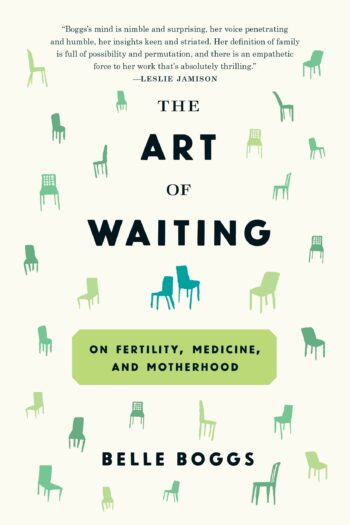
Early in The Art of Waiting, Belle Boggs tells us that she once asked her father, “Does having kids really squash all your dreams?” The answer comes after a moment: “Yep,” he said, “And it takes all your money too.”
But having children is a dream many people, Boggs included, don’t want to give up on, even when they discover that their only options may be adoption or ART: assisted reproductive technology. The Art of Waiting is the story of Boggs’s own struggles with infertility and her attempts to make her way through the complex world of infertility treatments, surrogacy, and adoption. She describes her eventual success with in vitro fertilization and the birth of her daughter, and she looks at cultural attitudes toward fertility, motherhood, medicine, and technology. Boggs explicitly sets out to provide comfort for those struggling with infertility, but her book is also valuable as a corrective, sometimes contrarian, look at how we think about bodies and science.
Infertility is a source of shame for many people because of the sense of failure and brokenness it can bring. In response, Boggs wonders, “What is wrong with having something wrong with you[?]” We don’t talk freely, in public at least, about the problems of the female body: periods, complications in pregnancy, menopause. We celebrate instead “the visible condition of pregnancy, in part because it is so visually obvious but also because it has been done to a woman and can be seen (incorrectly) as something she endures or even passively enjoys rather than as something she has to handle.”
But we all suffer from bodies that break down, that limp along, that sometimes barely work. We all have things “wrong” with us. Two groups of people are often told that their bodies are “miracles”: teenagers undergoing puberty and pregnant women. The body as a miracle, Boggs argues, is the wrong metaphor. Instead, we are “jury-rigged compromises,” just good enough to survive and propagate the species, and sometimes not even that.
To need medical treatment is normal, Boggs argues; the problem comes when we see medicine and surgery as replacements for the body instead of aids to it, and this is particularly true with infertility treatments. Too often doctors say that they will “take over” women’s bodies; they will fix their cycles and get them pregnant, thus removing agency and rendering women entirely passive. But what doctors really offer is assistance, helping the body to do its own work.
Assisted reproduction can also seem undignified. We think of pregnancy and childbirth as a natural process, while ART involves self-administered injections, transvaginal ultrasounds to monitor ovaries, having one’s eggs aspirated into a needle, and other uncomfortable and awkward procedures. But, as Boggs argues, much of life is undignified: “One could argue that certain diets lack dignity, as do going to the gym, having a colonoscopy, and performing many kinds of home repair. And when was sex ever dignified?”
Our cultural ambivalence about infertility treatments stems from our discomfort at some women’s refusal to accept things as they are, a discomfort that’s heightened when that refusal fails. When a woman grasps at what might be out of reach, it can make many people, notably those with religious objections to IVF and other treatments, uncomfortable. But Boggs portrays this desire to have more than what nature has offered as understandable, empowering, and even heroic. It’s a decisive, committed stance, one that makes a woman’s choice central.
Resisting infertility is also hugely expensive, and Boggs writes incisively not only about the sacrifices and costs involved, but also about how access to treatment is not available to everyone equally. Quality of health insurance—if one has insurance at all—varies widely, and laws about mandatory coverage of IVF differ greatly from state to state, as does the possibility of religious exemptions to allow companies to refuse coverage. Boggs shows that it’s economic status and quality of insurance coverage that most clearly determine success with ART, as those who live in Massachusetts, for example, where coverage is nearly universal, can rest knowing they are insured and their attempts to have a child won’t bankrupt them.
Boggs usefully explores other sources of reproductive inequality, including for LGBTQ couples, for whom adoption is much harder than for straight couples. She discusses surrogacy as another option, but one fraught with ethical dilemmas and legal constraints. Racial and class bias is a problem as well, and Boggs describes how IVF is marketed toward affluent white couples, even as lower-income people and minorities are more likely to struggle with infertility. One researcher found that 62% of fertility clinics feature only white babies in their advertising; as one woman said, “In the waiting room, every face you see is white. Looking at the literature, every face you see is white… It’s extremely isolating.”
As useful as this book is as a source of information and cultural critique, it’s also valuable as a source of comfort. Boggs wants to provide the solace that has been missing in literature. Drawing on figures such as Sarah from the Bible and George and Martha from Who’s Afraid of Virginia Woolf?, Boggs shows how ingrained the image of the infertile woman as incomplete, damaged, and damaging is in our culture. This image even appears in her own work: her first book of stories, written before her attempts to conceive, is haunted by the idea of the infertile woman as desperate and greedy. She would rewrite some of her characters if she could.
The Art of Waiting attempts to fill the void left by these negative portrayals. Boggs wants her readers—those struggling with infertility and those not—to know that infertility is a natural phenomenon and that using whatever methods are available to help one’s body along is also natural, and to be admired. For those who cannot conceive, even with ART, she also has words of comfort. Unlike animals who also experience infertility, humans are aware of time passing as they wait and hope to bear children, which can be a source of suffering. But “we have something animals lack, which is the conscious possibility of a new purpose, a sense of self not tied to reproduction.” It is possible for humans to imagine and create a meaningful life without biological offspring, and “perhaps knowing that [a new purpose] comes, and understanding infertility as a natural, perhaps even useful phenomenon, can provide us with a measure of peace.”
Boggs wants to rewrite the old stories about what happens to women who cannot conceive, and she wants her readers to see that they can rewrite their own stories too. They can come to their own understanding of what makes a meaningful life and what role children might or might not play in it. Having kids might squash all your dreams, as Boggs’s father claimed, and not having kids might squash them as well. But this book shows that it’s possible to find new dreams and, even in the midst of long periods of waiting, to imagine new paths forward.





